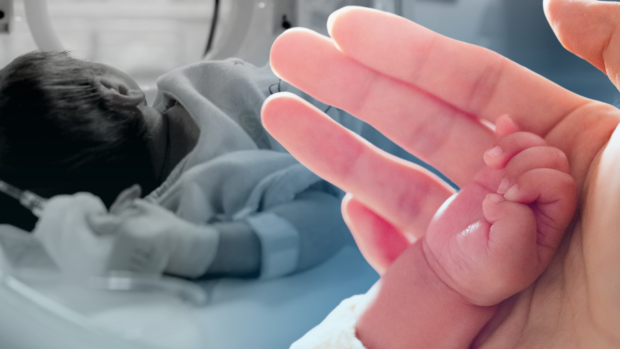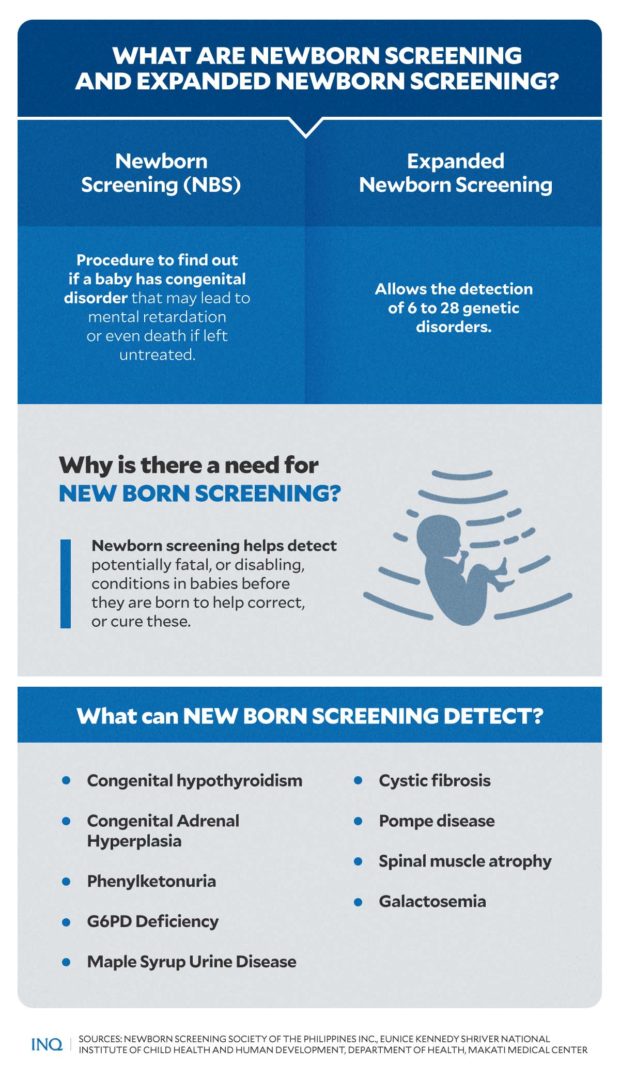Newborn Screening Week: Preventing infant deaths one test at a time
MANILA, Philippines—Approximately 6,700 newborn deaths occur every day, according to the World Health Organization (WHO). The deaths are often attributed to conditions and diseases associated with lack of quality care given immediately after birth and in the first days of life.
Data from WHO said that in 2020, nearly half—47 percent—of all deaths under the age of 5 occurred in the newborn period or within the first 28 days of life.
In the same year, 2.4 million newborns died globally due to conditions and diseases that could have been easily detected and addressed through a standard procedure: newborn screening.
To prevent newborn deaths in the Philippines, in 2004, then President Gloria Macapagal Arroyo declared the first week of October as National Newborn Screening Week through Proclamation No. 540.
Republic Act No. 9288, or the Newborn Screening Act of 2004, introduced the National Newborn Screening Systems, which ensure that every baby born in the country is offered the opportunity to undergo newborn screening.
Article continues after this advertisementIn this article, INQUIRER.net will try to explain more about newborn screening, its importance, the cost of screening babies, and what happens after babies undergo the procedure.
Article continues after this advertisementWhat is newborn screening?
According to the Department of Health (DOH), newborn screening is an essential health procedure done on newborn babies that enables the early detection and management of several congenital disorders—which, if left untreated, may lead to mental retardation or death.
“Early diagnosis and initiation of treatment, along with appropriate long-term care, help ensure normal growth and development of the affected individual,” the DOH said.
“It has been an integral part of routine newborn care in most developed countries for five decades, either as a health directive or mandated by law,” it added.
In the Philippines, newborn screening services have been available since 1996.
Aside from newborn screening, there is also the Expanded Newborn Screening (ENBS), defined by the Newborn Screening Society of the Philippines Inc. as a procedure that allows the detection of at least six to 28 genetic disorders in newborn babies.
After 24 hours from birth, a few drops of blood are taken from the baby’s heel and blotted on a special absorbent filter card. The blood sample for ENBS may be collected by any of the following: a physician, nurse, medical technologist, or trained midwife.
The blood sample will then be sent to a Newborn Screening Center (NSC).
Aside from a blood test, the newborn screening process also involves hearing tests and pulse oximetry tests.
According to Makati Medical Center (MMC), two different tests are used to determine if there are hearing issues in the newborn—the Auditory Brain Stem Response (ABR) Test and the Otoacoustic Emissions (OAE) Test.
“Both processes are quick, safe, and comfortable, and are often done while the baby is sleeping,” MMC said.
The pulse oximetry test is a non-invasive test that measures how much oxygen is in an infant’s blood.
“Babies with heart issues may show low blood oxygen levels. A pulse oximeter machine is used for the test, which utilizes a harmless sensor placed on the baby’s skin,” MMC explained.
“The pulse oximetry test can also determine if an infant has Critical Congenital Heart Disease (CCHD),” it added.
Why screen your baby?
Newborn screening helps detect genetic and metabolic abnormalities, hearing problems, specific heart problems, and other conditions considered potentially fatal or disabling in newborns.
“Most babies with metabolic disorders look ‘normal’ at birth. By doing ENBS, metabolic disorders may be detected even before clinical signs and symptoms are present,” said the Newborn Screening Society of the Philippines Inc.
According to MMC, newborn screening is essential since it helps with the early diagnosis of conditions that, if left untreated, may cause serious problems.
It also allows medical experts to provide treatment as soon as possible, “before the disease even turns serious or so early interventions can be made.”
The DOH said that among the conditions or diseases that can be detected through newborn screening were:
- Congenital hypothyroidism
- Congenital Adrenal Hyperplasia
- Phenylketonuria
- G6PD Deficiency
- Maple Syrup Urine Disease
Newborn screening can also detect rare but serious medical conditions, such as:
- Cystic fibrosis
- Pompe disease
- Spinal muscle atrophy
- Galactosemia
How much does it cost?
The ENBS costs P1,750, according to the Newborn Screening Society of the Philippines, Inc.
It is, however, already included in the Newborn Care Package (NCP) for PhilHealth members—a PhilHealth benefit package for essential health services of the newborn during the first few days of life.
The package covers essential newborn care, expanded newborn screening, and hearing screening tests.
Newborns are eligible for NCP if all of the following conditions are met:
- Either of the parents is eligible to avail of the benefits
- Born in accredited facilities that perform deliveries (such as hospitals and birthing homes)
- Services were availed of upon delivery.
Currently, there are seven newborn screening centers—with several newborn screening facilities—across the country. These are:
- Newborn Screening Center Northern Luzon: Mariano Marcos Memorial Hospital and Medical Center (590 newborn screening facilities)
- Newborn Screening Center Central Luzon: Angeles University Foundation Center (1,107 newborn screening facilities)
- Newborn Screening Center: National Institutes of Health, University of the Philippines Manila (1,471 newborn screening facilities)
- Newborn Screening Center Central Visayas: Eversley Childs’ Sanitarium and General Hospital (756 newborn screening facilities)
- Newborn Screening Center Visayas: West Visayas State University Medical Center (490 newborn screening facilities)
- Newborn Screening Center Mindanao: Southern Philippines Medical Center (1,828 newborn screening facilities)
What happens after?
Results of the tests will be available after seven to 14 working days from the time samples are received at the newborn screening centers.
A negative screen means that the ENBS result is normal. However, a positive screen means that the newborn must be brought back to the health practitioner for further testing.
“Babies with positive results must be referred at once to a specialist for confirmatory testing and further management,” the Newborn Screening Society of the Philippines Inc. said.
Some babies also require a repeat test one to two weeks after birth, according to MMC.

